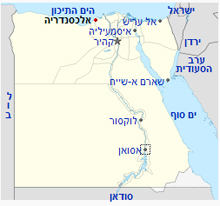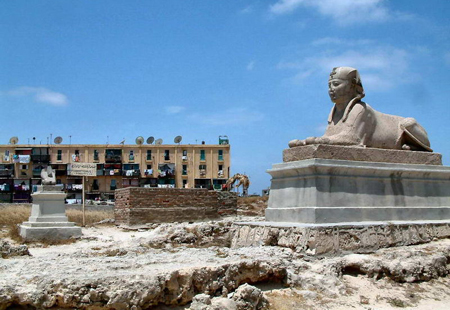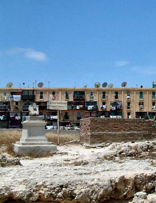Reflections
The Jews of Alexandria
One of the most glorious kehillos during the period of the second Beis haMikdash was the Jewish community of Alexandria in Egypt. Chazal say about the beis knesses of this kehillah that a person who never saw this building, never saw the glory of the Jewish people in his lifetime.
Some twenty years after this new city was built, Alexander of Macedonia died, and the new ruler of Egypt was Ptolemy the First, who was the founder of the Ptolemy dynasty which was to rule over Egypt for close to three hundred years. Ptolemy designated Alexandria as the capital of Egypt, transforming it into an important and beautiful city. During the period of his rule, the first Jews settled in Alexandria; it is not clear if these Jews were new arrivals from Eretz Yisrael, or whether they had merely moved there from other locations in Egypt. According to the writings of the famous historian of this period, Yosefus Flavius, King Ptolemy the First brought over more than a hundred thousand Jews to Alexandria, in order to protect the borders of his country. The Jewish population of the city grew rapidly, and a large and glorious kehillah swiftly took form, which enjoyed religious independence as well as total freedom to conduct its cultural life as it wished. The city of Alexandria continued to develop, until at the peak of its prominence it numbered several million inhabitants, living in five neighbourhoods. The Jews were concentrated in two of these neighbourhoods.
During the period of the second Beis haMikdash, Choniv the fourth was exiled from Eretz Yisrael to Egypt. Choniv was the son of Shimon haTzaddik, from a large family of kohanim who served in the Beis haMikdash. Chazal are divided on what exactly transpired. Rabi Meir argued that Shimon haTzaddik ordered his son Choniv to serve as Kohen Gadol after him, which aroused the envy of Choniv’s older brother Shimi, the bechor (eldest son) of Shimon haTzaddik. Shimi then libelled Choniv with false accusations, which were accepted to the extent that the other kohanim sought to kill Choniv, who was then forced to flee to Egypt. There in Egypt, according to Rabi Meir, Choniv built an altar and offered incense on it to idols. Rabi Yehudah disagreed with this version of events. He argued that Shimon haTzaddik in fact ordered Shimi to serve after him as Kohen Gadol, and that it was Choniv who attempted to libel him. When the evil designs of Choniv were uncovered, Choniv fled to Egypt, where he built an altar, upon which he burned incense – but according to Rabi Yehudah, his intentions were to serve Hashem, in accordance with the verse in Sefer Yeshayahu; “On that day there will be an altar to Hashem within Mitzrayim.”

The sanctuary that Choniv built in Alexandria was an almost-exact copy of the real Beis haMikdash, with only slight variations, in order to accentuate its lesser status than the authentic version in Yerushalayim.The vessels of the sanctuary in Alexandria, as well as the altar itself, were made as exact replicas of those in the Beis haMikdash, except for the seven-branched Menorah, which was made without a pedestal – its Egyptian copy was suspended from the ceiling by a chain.
The sanctuary of Choniv served the Jews of Alexandria for many long years, even after the destruction of the Beis haMikdash in Yerushalayim. In most places in which Chazal mention the sanctuary in Alexandria, they relate to it as somewhere that was built and used with pure intentions. This was especially the case after the Beis haMikdash itself was destroyed, since according to most opinions, other altars were then once again permitted, and so the Egyptian sanctuary acquired the status of a ‘bamah’. The sanctuary of Choniv was locked up and sealed by the Romans, after many fugitives from Eretz Yisrael, including many Sikri’im, barricaded themselves there and used the opportunity to plot against the Romans. After it was sealed off, it was destroyed – and approximately a hundred years ago, part of its remains were unearthed in the course of archaeological excavations.
The town of Alexandria is also cited by Chazal in connection with the ‘Targum Shivim’ (Septuagint, translation of the Tanach) that was composed there. This translation was made upon the order of the Egyptian King Ptolemy. Chazal describe the occasion of the translation as follows; “An event that occurred with King Ptolemy – he assembled the seventy-two elders and placed them in seventy-two separate chambers, without revealing to them the purpose behind his actions. He then entered each chamber in turn, and told the elders to translate for him the Torah of Moshe their leader. Hakadosh Baruch Hu put into each of their hearts the identical thoughts, and they all agreed [in their writings] to the same interpretations.” Chazal continue with their explanation of this event, relating that this miracle was necessary in order that none of the elders should write an interpretation of the verses that could be later used by Ptolemy to suggest that the Torah was incorrect chalilah, or to enable alternative interpretations which did not coincide with the truth. Each of the elders decided on the identical interpretations of the verses, without having any knowledge of the translations made by the others – thus the seventy-two made identical translations. One of the alterations they all made to the literal translation of the text is mentioned by Chazal – in relation to the prohibition against eating the rabbit. The word ‘arnevet’ was altered by all the elders and translated as ‘young feet’ – because Ptolemy’s wife was called ‘arnevet’ in Egyptian, and the elders feared that if they wrote the correct word, Ptolemy would assume that the elders and the Torah were mocking him.
The wealthy Jews of Alexandria built a huge beis knesses which was exceptionally beautiful. Chazal stressed its beauty when they wrote that; “Whoever did not see the ‘Diplaston’ of Alexandria, has never seen in his lifetime the glory of the Jews.” Chazal describe the building itself, and inform us that on occasion the number of Jews who were gathered in it to pray were double the amount of those who left Mitzrayim – a tremendous number – one million two hundred thousand Jews. In the beis knesses there were seventy-one golden thrones for the seventy-one elders who led the people. In the centre of the beis knesses there was a wooden platform, upon which the chazzan would stand during prayers. Because of the great size of the building, not all the mispallelim could hear the chazzan, and so, whenever the chazzan finished a brachah, someone was appointed to raise his hands in the air, signalling to the mispallelim that they were then to answer ‘amen’. In the beis knesses itself, the people were seated in groupings according to their professions, so that anyone who was in need of a particular professional should know where to go to in the beis knesses, in order to hire the craftsman he sought. This arrangement was also intended to assist the craftsmen themselves, in order that they should not, chalilah, become impoverished.
Not one remnant of this huge beis knesses has been discovered. In the Talmud Bavli, the circumstances relating to its destruction are described, and how it adversely affected the Jews of Alexandria, since many Jews were slaughtered when the beis knesses was destroyed, by the Roman Emperor Trianus (or according to another version, by Alexander of Macedonia, who was possibly a different Greek king who lived in a later period than Alexander the Great, who established the city). Chazal state that the destruction of the beis knesses and the slaughter of the huge number of Jews who were found within it was a punishment for the Jews having settled permanently in Egypt who in doing so transgressed the prohibition of “You shall not return in that direction any more.” Since the Jews of Alexandria had disregarded this mitzvah, Hakadosh Baruch Hu brought Trianus against them to murder them. When Trianus reached the beis knesses, he heard that the Jews inside were currently learning the verse, “Hashem will cause a nation from afar to rise up against you.” Upon hearing this, Trianus surmised to himself that the verse must be referring to him, since he had travelled from afar on a journey that usually took ten days to complete, but due to favourable winds that had propelled his ship swiftly forwards, he had arrived in just five days, half of the usual duration. Therefore, he deduced that Hakadosh Baruch Hu must have designated him as the one to rise up against the Jews, and upon arriving at this conclusion, he killed all the hundreds of thousands of Jews who were then in the beis knesses.

During the Roman period almost half the population of Alexandria was Jewish. Even prior to the destruction of the second Beis haMikdash these Alexandrian Jews tried to rebel against their Roman overlords. The background to their rebellion was the demand of these Jews that they be accorded equal rights to the Greek inhabitants of the city. The demand and the following rebellion then led to rioting of the Greeks against the Jews, with the Greeks being aided by Roman soldiers, who had been commanded by the local Roman ruler in Egypt to quell the rebellion. Approximately forty years later the great rebellion broke out in Eretz Yisrael, which culminated in the destruction of the second Beis haMikdash. The Jews of Alexandria took part in this rebellion, and their own uprising was brutally crushed. Approximately fifty thousand Jews from the kehillah of Alexandria were killed. This was an especially painful occurrence, due to the fact that the person responsible for the crushing of the rebellion, appointed by the Romans, was Tiberius Julius Alexander, who was an apostate Jew, originally from a prominent family of community leaders.
The largest rebellion in which the Jews of Alexandria took part was the ‘Dispersed Rebellion’. This rebellion broke out some forty years after the destruction of the Beis haMikdash, and was located in three main areas. The largest centre of the rebellion was in the area of Cirnacea, which is today known as Lov; the second location was in Cyprus; and the third was in Alexandria. This rebellion was brutally crushed by Trianus, whose soldiers murdered hundreds of thousands of Jews in the course of their attack, leaving just a tenth of the Jewish population alive after the rebellion as compared to before. It appears that it was either around the time of or during the course of this rebellion that the huge beis knesses of Alexandria was destroyed – however, there are some historical accounts that place this event some two hundred years previously. After the ‘Dispersed Rebellion’ was suppressed, a Jewish community continued to exist in Alexandria, but it never reattained its former glory. Some three hundred years later, the Jews of Alexandria were expelled from the city by its Byzantine rulers, and this once proud and prominent community ceased to exist.
Over the years occasional Jews did reside in Alexandria, including several prominent families who lived there for short periods of time, such as the family of Rabi Moshe ben Maimon, the Rambam. Another glorious period of Jewish Alexandria occurred at the end of the period of the Gaonim, when four great talmidei chachomim, who were gedolei Yisrael were taken captive – these were Rabbeinu Chushiel, the father of Rabbeinu Chananel; Rabi Moshe (with his son Rabi Chanoch); Rabi Shemarya the son of Rabi Elchanan; and a fourth sage whose name is unknown. The first of these captives, Rabi Shemarya the son of Rabi Elchanan, was redeemed by a Jew from Alexandria, and he quickly rose to prominence in that city and was appointed as the head of the Jewish community there. The kehillah only began to expand again, however, some two hundred years ago, when progressive winds from Europe reached the city and opened it to international trade. Following this development, Jews settled in the city in large numbers, reaching a peak of more than ten thousand residents at one point. However, this new period of expansion was not to endure; following the establishment of the State of Israel, most Jews left Egypt, and today, only a small number remain.







